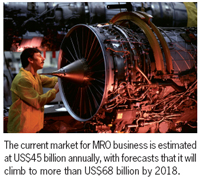 In his keynote address at the event, S. Iswaran, Senior Minister of State for Trade and Industry in Singapore said: “In spite of the weak immediate outlook for airlines and the MRO industry, the long term prospects of the aerospace industry remain positive.”
In his keynote address at the event, S. Iswaran, Senior Minister of State for Trade and Industry in Singapore said: “In spite of the weak immediate outlook for airlines and the MRO industry, the long term prospects of the aerospace industry remain positive.”
He noted that at July’s Farnborough Airshow, significant new orders for aircraft continued to be placed with Boeing and Airbus, particularly from the emerging economies of the Middle-East, China and Russia. Demand has also come from airlines seeking to replace their fleets with more fuel efficient aircraft.
He added that the past few weeks had been a turbulent period for financial markets and the effects on the economy will be profound, however, the easing of fuel prices has provided some relief.
And despite these upheavals, he said that planned infrastructure work in Singapore – the largest MRO centre in the Asia-Pacific region – would continue, despite the weak immediate outlook for the aerospace industry.
“We see this as the occasion to prepare the infrastructure and manpower capabilities needed for future growth,” he said. “Singapore remains committed to developing the aerospace industry and reinforcing our status as an air hub. Th ese are important pillars of our economy.”
Singapore’s aerospace industry has experienced a 13 per cent compoundedannual growth rate since 1990.
Singapore continues to invest
To support continued growth, Singapore is developing the 300 ha Seletar Aerospace Park as an integrated aerospace cluster, which will host MRO, manufacturing and business aviation activities. Major investment commitments have already been made by major aerospace players including Rolls Royce, Pratt & Whitney, ST Aerospace, BJETS and others.
He highlighted the S$320 million (US$212 Million) Rolls Royce engine assembly and test facility which is the first such facility for the engine manufacturers outside of Europe and will produce engines for the B787 and A350XWB.
Singapore’s investment in the MRO sector is clearly on the money if most industry pundits are on the mark as to where the industry is heading.
Most expect the market to continue to contract in the traditional markets of North America and Europe, as China, India and the Asia-Pacific in general grow in importance as MRO centres.

A shifting MRO market
North America’s share will continue to fall over the next decade, from 37 to 29 per cent according to Michael McBride, VP and principal at aviation consultancy TeamSAI, which estimates the current MRO market to be worth US$45.1 billion annually, but climbing to US$68.6 billion by 2018.
Western European MROs will also lose about 2 per cent of their market share over the 10-year forecast but Eastern European MROs will gain 3 per cent, as some of the airframe work, in particular, shifts.
China’s share of the MRO market will grow from US$2.7 billion to US$5.4 billion while India’s share will climb from US$0.5 billion to US$1.6 billion, and the rest of the Asia-Pacific region will climb from US$6.0 billion to US$11.1 billion.
David Stewart, a principal with consultancy AeroStrategy, said because aviation growth in Asia-Pacific is still relatively high, he expects global MRO players and integrators to likely “follow the money” during the downturn. AeroStrategy’s 10- year MRO forecast links Asia-Pacifi c carriers to 22% of the MRO market demand, or $10.2 billion of what it thinks in 2007 was a $45 billion global market.
A new paradigm
Also speaking at the event was William Tan, CEO of SIA Engineering (SIAE), who highlighted that the MRO business was moving into a distinctly new paradigm, “where doing more of the same is no longer enough.”
“Business models have to be recalibrated to meet new customer demands for total life cycle solutions. New generation aircraft will increasingly change the way we do MRO, which requires us to invest in the training of our people. Lastly, we need to work closely with all stakeholders in the aviation industry, as higher overall operating efficiencies are predicated on a strong network of relationships among all parties in the MRO value chain.”
Chow Kok Wah, Divisional Vice President of Engineering at Singapore Airlines, agreed, adding: “Surviving players in the industry will be the ones that recognise trends and adapt with each crisis.”
Chow suggested several ways of dealing with the current financial crisis, including fixed maintenance prices, like the pay-perhour model Singapore Airlines has applied to its engine and component maintenance, and higher aircraft utilisation. “Increasing utilisation from 12 hours a day to 13 hours a day is a productivity increase of 8 per cent,” he said.
“An airline with a 100 airplane fleet can now dispense with 8 airplanes … worth US$800 million and reducing annual maintenance by US$2-3 million.”
————————————————————————
Editor’s Note
Starting with this November issue of Payload Asia, we are pleased to bring you regular coverage of the maintenance, repair and overhaul (MRO) segment of the aviation business. Although not a direct element of the air cargo business, it is none-the-less an important aspect of any carrier’s business, whether passenger or dedicated maindeck cargo carrier. We hope you find this section informativeand we welcome any feedback you might have. – the Ed
————————————————————————










